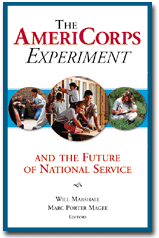
|
|
Book Review: The AmeriCorps Experiment and the Future of National Service
 Progressive Policy Institute, Washington, DC, 2005, 146 pp., $14.95, fully available online. The AmeriCorps Experiment and the Future of National Service provides an appraisal of AmeriCorps as it passes the ten-year mark, and includes the diverse viewpoints of leaders across the political spectrum about the potential future of the program, though it's principally informed by the co-editors and their institutional bonds. Will Marshall is president and founder of the Progressive Policy Institute (PPI), the think tank associated with the Democratic Leadership Council, supported by its “Third Way” political philosophy (that, among other things, "seeks to adapt enduring progressive values to the new challenges of [t]he information age.") Marshall is theauthor of the 1988 DLC book Citizenship and National Service that developed many of the ideas for AmeriCorps. Marc Porter Magee is Research Director of the Partnership for Public Service, and was previously director of PPI’s Center for Civic Enterprise and a contributing editor of the DLC journal,Blueprint. The first section, "Assessment," features only one chapter, “Has AmeriCorps Lived Up to Its Promise?” by Magee and Marshall. The chapter presents AmeriCorps' success in its primary purpose of “tackling unmet needs, expanding opportunity, bringing Americans together through service, and strengthening citizenship and civic enterprise.” Still needing more attention are encouraging more members to pursue higher education with their Education Awards, and increasing interaction between diverse members.“Part Two: Service at Home and Abroad: An Update” includes a “A Frontline View” by David Eisner, current CEO of the Corporation for National and Community Service (CNS). Eisner presents some of the challenges that AmeriCorps has faced in its first ten years — lack of bipartisan support and a fiscal/management crisis, and offers his recommendation for three ideas in particular: (1) that AmeriCorps members can increase their effectiveness exponentially by recruiting and coordinating other volunteers at their sites. (2) Greater grantee matching of Federal funds ("…a key measure of its strength and long-term viability”). (3) Eisner is the first of nearly all of the contributors to this book to cite the great potential of tapping into the baby boomer generation that is beginning to retire, those 77 million strong who came of age in the idealism of the New Frontier and the social movements of the Sixties and Seventies that is beginning to retire, and he recommends adapting current programs and benefits to attract them. “A Global Perspective,” by Susan Stroud, Executive Director of Innovations in Civic Participation, compares and contrasts national service in various countries, from alternatives to military service conscription to programs more closely associated with higher education. They provide models for further developing national service programs here in the U.S. Stroud suggests that the international growth of service programs, particularly for youth, might eventually trend toward “a common experience and expectation for the majority of young people worldwide.” “Part Three: Possible Futures for National Service” includes essays by contributors from both sides of the political spectrum. In “Putting Faith in Service,” Beliefnet’s Steven Waldman recommends that 100,000 religious congregations each host a national service member who would stay with a parishoner’s family while working with the congregation to coordinate volunteers for their community service work. In “National Service on a Community Scale,” Bush Administration CNS Chair Stephen Goldsmith represents those concerned about too much Federal government intervention in communities as well as a move toward some form of conscripted service, not to mention a critical eye towards too large a percentage of funds going to big national organizations such as City Year and the Red Cross. He recommends that AmeriCorps focus more on supporting grass-roots community-based efforts. A very different viewpoint is represented in “The Case for Universal Service” by William A. Galston, Director of the Institute for Philosophy and Public Policy at the University of Maryland (the Institute's scholars constitute the Philosophy & PublicPolicy Quarterly Editorial Board). Galston makes a passionate call for moving to a universal conscription system, allowing for military or civic service, as a way to instill in American youth a deeper sense of citizenship. Lastly, Marshall and Magee return in “The Voluntary Path to Universal Service” outlining a proposal for the expansion of national service, inspired by the post-WWII G.I. Bill, that more directly ties financial aid for higher education to public service, civic or military. The essay outlines “Five Ways to Scale Up National Service: 1.Replace selective service with national service, 2. Expand AmeriCorps, 3. Recruit more citizen soldiers, 4. Replace work study with serve study, 5. Link federal student aid and national service.” It might be taken as a holdover of Clinton era brashness that they take a swipe at the forerunners of AmeriCorps: “National service ought to be more than a small demonstration project on the margins of big government. It must take a great leap forward or risk going the way of the Peace Corps and VISTA, noble endeavors that languished after an initial burst of inspiration and failed to reach critical mass.” It seems unfortunate that the editors, especially in writing this concluding article, did not more fully integrate some of the ideas presented in previous chapters. This gives the impression that the other essays provide more of a perfunctory nod toward presenting political balance. Whether this can become a forceful bi-partisan or multi-partisan opportunity for collaborating on a workable proposal that can be supported by a spectrum of policy makers (like the McCain-Bayh proposal for Universal Service that Marshall and Magee discuss) remains to be seen. Dan Schackman has been Assistant Editor of the ComTechReview from the Winter 2004-05 issue through this issue, and served as a VISTA Leader for the CTC VISTA Project in 2004-05 and as a VISTA at CTCNet from 2002-04. He is currently a doctoral student in Mass Communications and Graduate Fellow at the S.I. Newhouse School of Public Communications at Syracuse University.
Hyperlinks references in this article: Comments
|